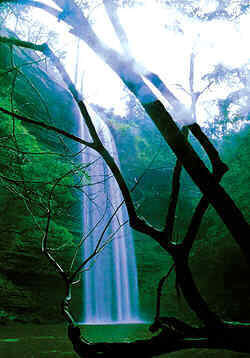 CULTURAL SPECIFICITIES CULTURAL SPECIFICITIES |
 SACRED TREES OF GHANA SACRED TREES OF GHANA
Although the majority of Ghanaians are Christians and Muslims, a good number still live in their old indigenous religious beliefs. Sacred groves all over the country are almost always associated with certain species of trees that produce shelter for the shrines.
Some recorded species:
Bahia Nitida - Odwen (Twi), Ceiba Pentendra -
Onyina (Twi), Dracaena arborea - Ntomme (Twi),
Erythrina addisonae - Osorswa (Twi), Ficus Vogelii -
Gjedua (Twi), Markhamia lutea - Efor-besi (Twi),
Mildetia thonningii - Santew (Twi), Newbouldia
laevis - Sesemasa (Twi), Trichilia heudelotii -
Otannuru (Twi), Veronica colorata - Awonwene (Twi),
Chlorophora excelsa - Odum (Twi), Cordia millenii -
Tweneboa (Twi) and Alstonia boonei - Nyamechua.

The trees in the groves are sacred, and so not even a leaf can be taken from them without permission. The Odum and Onyina on the basis of their imposing appearances, are regarded as tree gods and are asked on sacred days for blessings for the village community. | The Tweneboa is used for carving all the drums used at the chief's palace or shrines.
 Some wild flowering trees and shrubs Some wild flowering trees and shrubs
It would be impossible to give a description of all the interesting plants in Ghana. Only a few of the most striking ones will be mentioned here:
Cassia sieberiana - commonly known as the Golden Shower. 9 meters high, short bole, wide spreading crown, shady. Bright yellow flowers, in heavily hanging clusters from November to February.
Bombax buonopozense - commonly known as the African Tulip Tree, 9-12 metres high, evergreen, found on roadsides and near villages. Attractive red flowers in heavy groups from September to December.
Erythrina Mildbreadii - 6-9 metres high, thick thorns on the stem, loses leaves when flowering. Pick flowers from November to February.
 FUNERALS FUNERALS
An Akan proverb states: "The hoe of death does not weed on one place" (Owu adare ndow faako). Death is everywhere, a natural part of the cycle of life.
Funerals in Ghana are a process rather than an event. This is especially true for the Akan people of southern Ghana whose mortuary practices are characterized by a prolonged period of mourning and a series of rituals that mark the transition of the deceased from that of a living member of the family and community to that of a revered ancestral spirit whose ties to the living are very much intact. It is common practice in contemporary southern Ghanaian mortuary rites for the body to lie in state for one or more days. While the body lies in state, mourners file by to pay their respects and offer symbolic gifts to accompany the deceased to the afterlife. |

